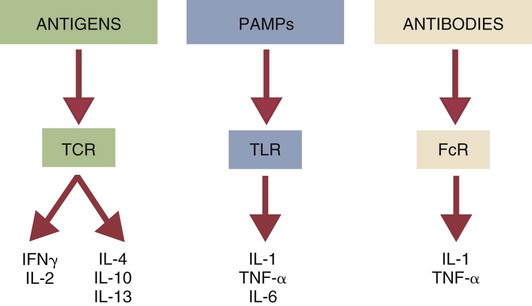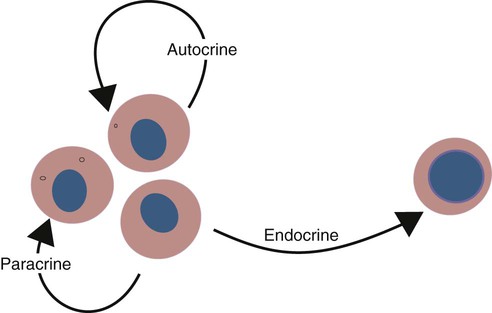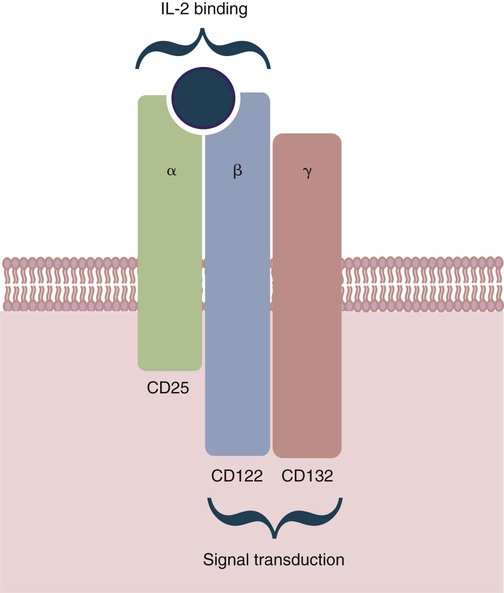• The immune responses result from multiple interactions among many different cell populations. • One way that these cells interact is by secreting specialized signaling molecules such as cytokines and hormones. • These signaling molecules bind to specific receptors on target cells. • When signaling molecules bind to their receptors, transcription factors are generated. These transcription factors then activate the transcription of selected genes. • As a result of changes in gene transcription, new proteins are produced and secreted, and affected cells alter their behavior, perhaps by dividing or even dying on command. The cells of the immune system can synthesize and secrete hundreds of different proteins that control the immune responses by communicating among cells. These proteins are called cytokines (Box 8-1). Cytokines differ from conventional hormones in several important respects. For example, unlike conventional hormones, which tend to affect a single target cell type, cytokines can affect many different cell types. Second, immune system cells rarely secrete a single cytokine at a time. For instance, macrophages secrete at least four interleukins (IL-1, IL-6, IL-12, IL-18) as well as tumor necrosis factor-α (TNF-α). Third, cytokines are “redundant” in their biological activities in that many different cytokines have similar effects. For example, IL-1, TNF-α, TNF-β, IL-6, high mobility group box protein-1 (HMGB1), and the chemokine CCL3 all act on the brain to cause a fever. Finally, cytokine-mediated signals are transient, and the messages delivered may vary over time as the cytokine environment changes. The interferons are cytokines produced in response to virus infection or immune stimulation. Their name is derived from the fact that they interfere with viral RNA and protein synthesis and so have antiviral activity (Chapter 26). There are three types of interferon. Type I interferons are a diverse family, the most important of which are interferon-α (IFN-α) and IFN-β. There is a single type II interferon, called IFN-γ. Three type III interferons (IFN–λ) have been identified. Type I interferons are primarily antiviral with a secondary immunoregulatory role. For type II and type III interferons such as IFN-γ and IFN–λ, the reverse is the case. Many type I interferons also play an important role in the maintenance of pregnancy. TNFs are cytokines secreted by macrophages and T cells. As their name suggests, they can kill tumor cells, although this is not their primary function. Thus TNF-α is the key mediator of acute inflammation. The TNFs belong to a large family of related cytokines, the TNF superfamily, which is involved in immune regulation and inflammation. Other important members of the TNF superfamily include CD178 (also called CD95L or Fas ligand) (Chapter 18), and CD154 (CD40 ligand) (Chapter 14). Chemokines are a family of at least 50 small cytokines that play an important role in leukocyte chemotaxis, circulation, migration, and activation, especially in inflammation. A typical example of a chemokine is CXCL8 (also known as IL-8). Chemokines are described in detail in Chapter 3. Cytokines are produced in response to many different stimuli. Examples of these stimuli include antigens acting through the T cell or B cell antigen receptors; antigen-antibody complexes acting through antibody receptors (FcR); pathogen-associated molecular patterns (PAMPs) such as lipopolysaccharides acting through toll-like receptors (TLRs); and other cytokines acting through cytokine receptors (Figure 8-1). Cytokines act on many different cellular targets. They may, for example, bind to receptors on the cell that produced them and thus have an autocrine effect. Alternatively, they may bind only to receptors on nearby cells; this is called a paracrine effect. Some cytokines may spread throughout the body, affecting target cells in distant locations, and thus have an endocrine effect (Figure 8-2). Cytokines are complex proteins with many diverse structures. They are classified based on these structures (Table 8-1). Thus the largest family, the group I cytokines (or hematopoietins), consist of four α helices bundled together. This family includes many different interleukins as well as growth hormone and leptin. Within the group I cytokines are two major subfamilies, the interferon subfamily and the IL-10 subfamily. Group II cytokines consist of long-chain β-sheet structures. They include the TNFs, the IL-1 family, and transforming growth factor-β (TGF-β). Group III cytokines are small proteins with both α helices and β sheets. These include the chemokines and related molecules. Group IV cytokines use mixtures of domains with mixtures of structural motifs and include the IL-12 family. Many cytokines, such as the IL-17 family, IL-14, and IL-16, are structurally unique proteins and do not belong to any of these major structural families. Table 8-1 Molecular Classification of Selected Cytokines Cytokines act through cell surface receptors. These receptors consist of at least two functional units, one for ligand binding and one for signal transduction (Figure 8-3). These units may or may not be on the same protein chain. Cytokine receptors can also be classified into classes based on their structure. A second class of receptor consists of proteins that also act as tyrosine kinases (Figure 8-4). These are typically growth factor and cytokine receptors. In these cases, binding of the ligand to two adjacent receptors forms an active dimer. The ligand-binding site, the membrane-spanning region, and the tyrosine kinase are usually separate domains of a single protein. Thus when the ligand binds to the extracellular domain, the receptor chains dimerize so that the two tyrosine kinases are brought together and activate each other. These kinases phosphorylate tyrosine residues on other proteins or even the receptor itself (autophosphorylation). Since many of these other proteins are also tyrosine kinases, phosphorylation also converts them to an active state. In this way a cascade of expanding phosphorylations develops within the cell (Figure 8-5). Phosphorylation triggers changes in cellular activities (Box 8-2). Many cytokines and other immunological signals operate through this type of receptor (especially through tyrosine kinases of the src family).
Cell Signaling
Cytokines and Their Receptors
Cytokine Nomenclature
Cytokine Functions
Cytokine Structure
STRUCTURAL FAMILIES
STRUCTURE
EXAMPLES
Group 1
Four α helix bundle
IL-2, -3, -4, -5, -6, -7, -9, -11, -13, -15, -21, -23, -30; GM-CSF, erythropoietin, G-CSF, prolactin, leptin
IFN subfamily
IFN-α/β, IFN-γ, IFN–λ
IL-10 subfamily
IL-10, -19, -20, -22, -24, -26
Group 2
β Sheets
TNFs; TGF-β; IL-1α, -1β, -18
Group 3
α Helices and β sheets
Chemokines
Group 4
Mixed motifs
IL-12
Ungrouped
Unique structures
IL-17A-F, -14, -16
Cytokine Receptors
![]()
Stay updated, free articles. Join our Telegram channel

Full access? Get Clinical Tree


Veterian Key
Fastest Veterinary Medicine Insight Engine




